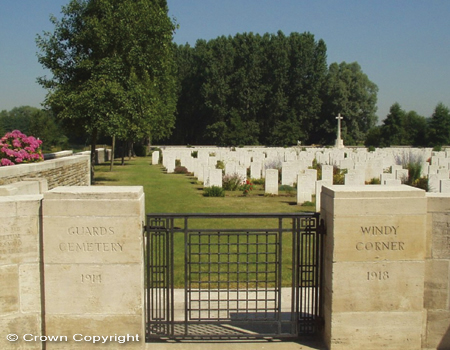|
PATROLLING ON THE AISNE
by Major P A J Wright OBE
formerly Grenadier Guards
|
 Grenadier Guards at Buckingham Palace - August 1914
Grenadier Guards at Buckingham Palace - August 1914 |
War came to Britain on 4th August 1914 when Germany invaded Belgium. The 2nd Battalion Grenadier Guards was at Wellington Barracks. It was well trained and its equipment was all ready when mobilisation orders were received. By 6th August nearly 3000 reservists had reported, been examined, clothed, armed and equipped and joined their battalions. Training was still being carried out and as the 2nd Battalion was returning to barracks from a route march, the King and Queen came down to the gates of Buckingham Palace. The men marched past in fours and saluted the King, their Colonel in Chief.
The Battalion, commanded by Lieutenant Colonel N A L Corry, with 29 officers and some 1000 men, crossed over to France on 12th August. It disembarked at Le Havre and marched out of the town to an overnight camp five miles away. In addition to its Headquarters and four Companies, the Battalion had a machine gun section, a signalling section, the quartermaster’s platoon and its transport (all horse drawn). The following day it entrained to begin the journey to the outskirts of Mons to meet the German threat.
In the first few months of the war, as part of the original British Expeditionary Force, the 2nd Battalion took part in the confusion of the withdrawal from Mons, the 190 mile march in two weeks under the late August sun to south of the Marne, and the cautious pursuit of the German army to the Aisne. Here fighting on the steep heavily wooded slopes of the Aisne valley eventually congealed into trench warfare with the armies of both sides locked in the mud of their static positions. ‘No man’s land’ between the trenches was covered in unburied bodies.
The trenches were gradually improved and deepened despite intense shelling from field guns and heavy howitzers. Rabbit netting was procured from the neighbouring woods and converted into wire entanglements. Raids were periodically made to stalk the enemy’s snipers hidden in trees, haystacks and wood stacks, which had been hollowed out and loop-holed. The skill of the highly trained soldiers with the Lee Enfield .303 rifle - fifteen rounds a minute minimum (the so-called ‘mad minute’) - was used to great effect, although the losses sustained by the Battalion were also considerable. Two patrols on the Aisne within a few days of each other illustrate both the effectiveness of this rapid firepower, which the Germans often mistook for machine guns, and the initiative and resourcefulness of the junior NCOs in command.
Lance Corporal P H McDonnell led a patrol with two men to reconnoitre a small wood a few hundred yards in front of the Battalion lines. They discovered a large party of about thirty Germans in an advanced trench at the forward edge. The enemy thought they had captured the three men and began to walk forward to take them prisoner. At this point McDonnell gave a sharp order to fire and the resulting hail of bullets from the patrol caused a considerable number of casualties. Before the Germans could recover from the confusion, the three Grenadiers had escaped. McDonnell was awarded the DCM. His citation read: ‘On 27th September made a first class reconnaissance and discovered an unsuspected German trench’. He later transferred to the Welsh Guards and was promoted to sergeant.
The citation for the DCM awarded to Lance Corporal W Thomas is more detailed: ‘On 1st October went with three men through a wood to burn a wood stack from which sniping took place, and meeting a patrol of fifteen Germans fired at them and drove them off. After waiting they went on and successfully lighted the stack’. The Battalion war diary records that two Germans were killed and that Thomas himself was badly hit. He was subsequently promoted to sergeant. On 3rd December, the King, accompanied by the Prince of Wales in Grenadier uniform, inspected 4th Guards Brigade at Meteren. It was his first visit to the front and he presented DCM medal ribbons to McDonnell and Thomas and five other members of the Battalion.
Thomas was killed in the trenches a few days later on Christmas Eve 1914 and is buried in the Guards Cemetery, Windy Corner, Cuinchy. An extract from a letter sent to his sister by the men of 4 Platoon of No 1 Company reads: ‘He was killed instantly by a shot in the head on the afternoon of 24th December. It may be a relief to you to know that he died fighting to the last. The Germans were in our trenches and he barred the way shooting down every man that came his way. He saved many of us and we greatly sympathise with you in your loss’.
Thomas’s Commanding Officer, Lieutenant-Colonel W R A Smith, wrote to Regimental Headquarters: ‘You will be sorry to hear that Sergeant Thomas was killed the other day. He got the DCM for good work on the Aisne and never received the medal. He came out as a Private and has worked his way up to Acting Sergeant by sheer merit. He was a gallant man and a great loss to No 1 Company.’
 The Guards Cemetery at Windy Corner, Cuinchy
The Guards Cemetery at Windy Corner, Cuinchy |
|
|


